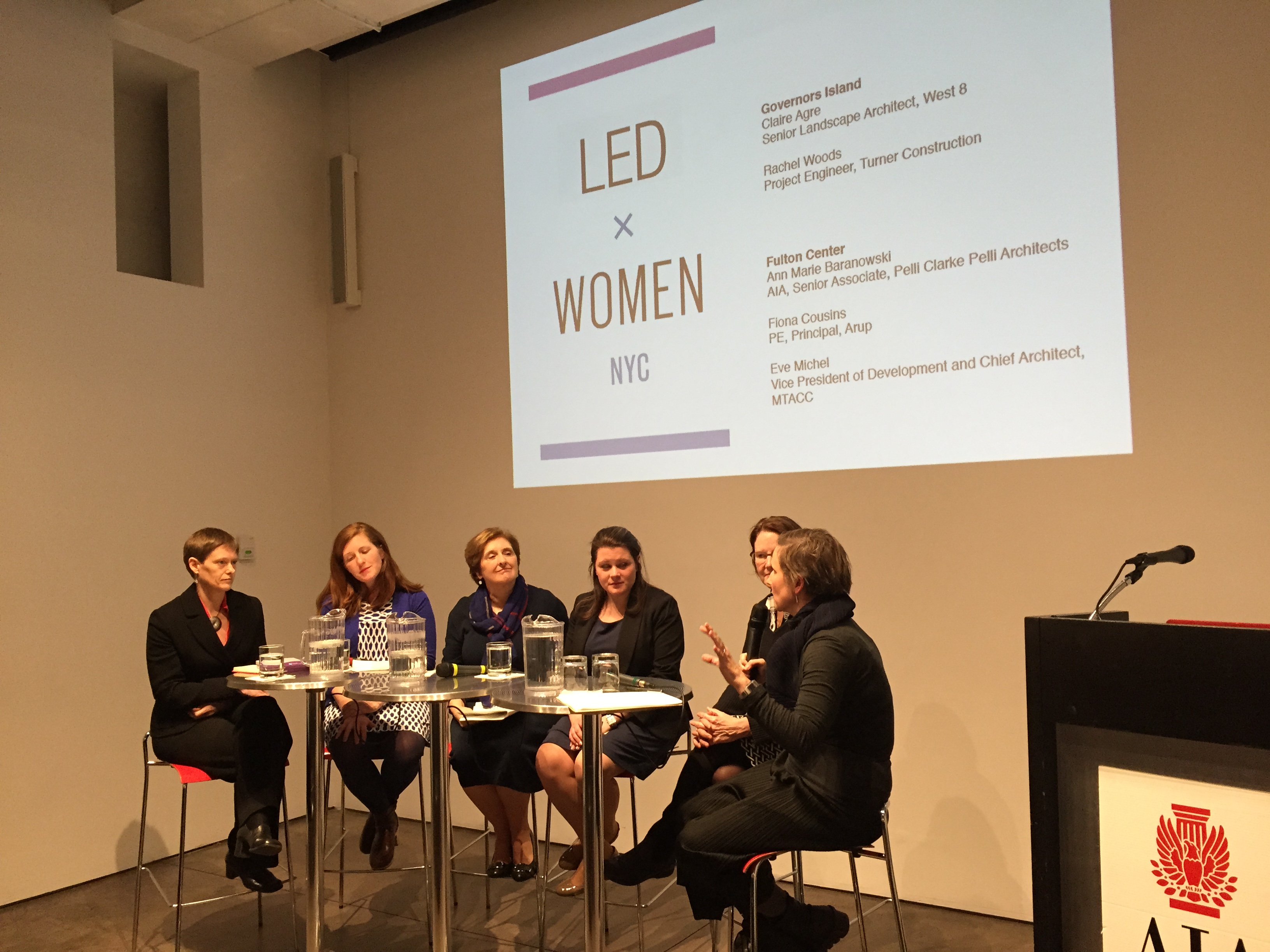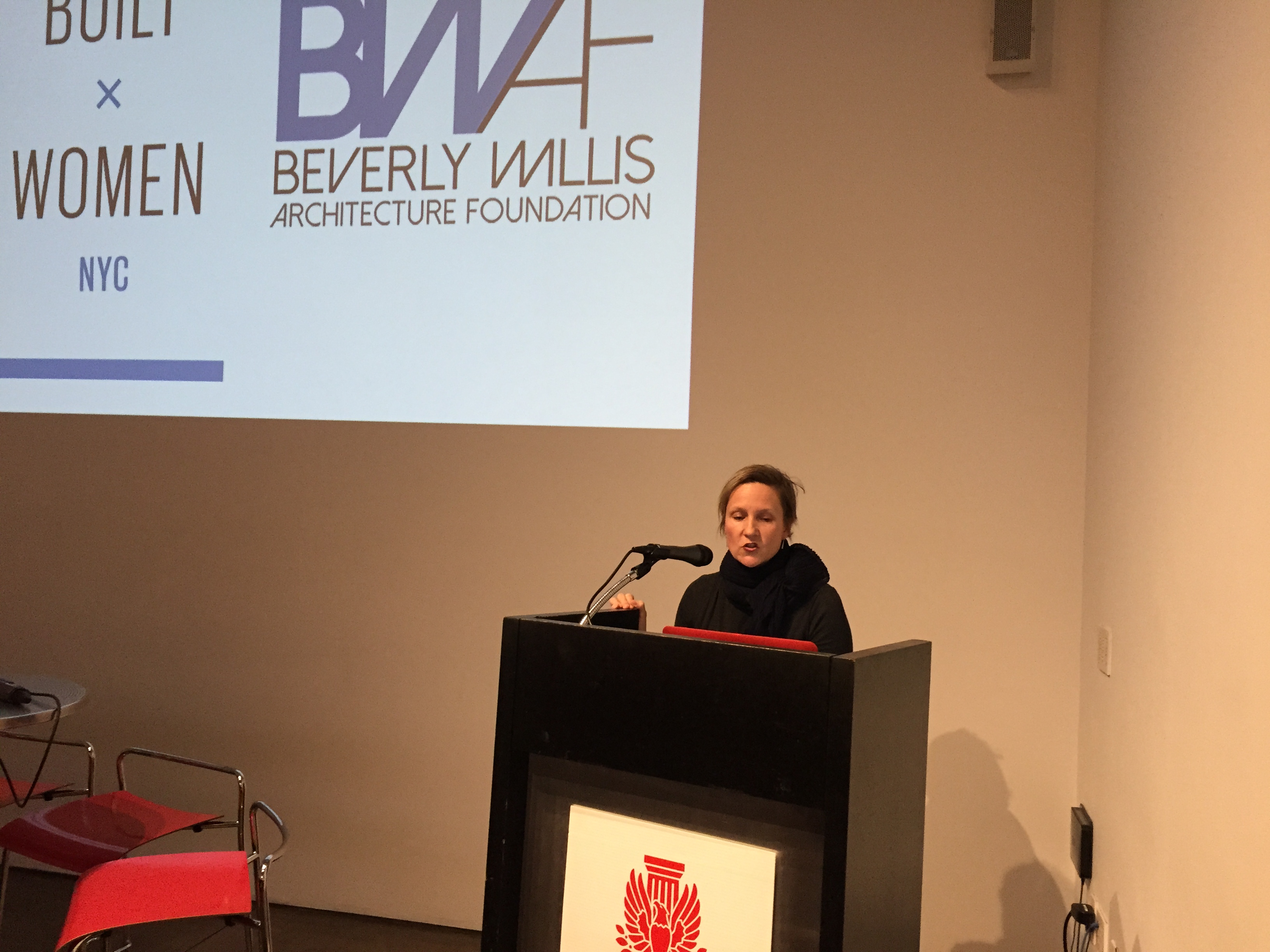by: Alexandra Tell
Carol Shapiro, director of the Beverley Willis Architecture Foundation (BWAF), opened the “Feminist Design Practices” panel at the Center for Architecture on 04.07.15, dedicating the event to the unsung women who have influenced the built environment. “Women in design are often invisible,” Shapiro lamented. The were anything but invisible that evening: six women spoke openly and honestly about their experiences as female professionals in architecture, engineering, construction, and academia on a panel organized by the BWAF and the AIANY Women in Architecture Committee in conjunction with the “Built x Women NYC” exhibition.
“Feminism is not just about women, it’s about social justice for everyone,” declared Lori Brown, associate professor of Architecture at Syracuse University and panel moderator. Brown discussed her research into the inherent biases in workplaces. She presented stark statistics that served as indicators of the structural and deeply-embedded bias against women in architecture. Women comprise a mere 15% of the deans at architecture schools across the country. There were no women on the jury to determine the Pritzker Prize until 1987. In the Pritzker’s 37-year history, only two women have been awarded the annual prize. These, according to Brown, are “models favoring the masculine.” Can we expect more women to attend architecture and engineering schools without bolstering the number of women in faculty and university leadership positions? Can we respect the Pritzker Prize as an arbiter of architectural greatness if it is mainly organized to recognize the greatness of male architects? Brown urged the audience to challenge the status quo on these issues. To make architecture, engineering, and construction more equitable fields, Brown suggested, there needs to be a paradigm shift. The widely-conceived goal should be “Led x Women,” she proposed.
The panel was comprised of female leaders from two recent projects – Governors Island and the Fulton Center. Claire Agre, senior landscape architect at West 8, and Rachel Woods, project engineer at Turner Construction, had vastly different experiences as women working on the Governors Island redevelopment. Agre described early planning meetings for the project, attended almost entirely by women, with The Trust for Governors Island a women-run organization. Woods, involved in the construction phase of the project, described “the old boys club” that is construction management. For the Fulton Center project, Ann Marie Baranowski, AIA, senior principal at Pelli Clarke Pelli Architects; Eve Michel, vice president of development and chief architect, Metropolitan Transit Authority Capital Construction (MTACC); and Fiona Cousins, PE, a principal at Arup, discussed a more even gender distribution in meetings. Cousins noted that although there were never many women at a single meeting, women always contributed significantly to projects, and that was well acknowledged by all in the firm, while Baranowksi described a “gender-neutral experience” working on Fulton Center.
Taking a wider view of women in architecture, engineering, and construction, the panelists talked about their experiences beyond these particular projects. Michel discussed how “fraternity” is a powerful force that disadvantages women in the workplace – during the recession when there were massive layoffs at a firm she worked at, she recounted, all of the men immediately landed new jobs while the women did not. Baranowski spoke of the difference that a firm’s culture has on the experience for women – are women encouraged and inspired to succeed? The culture, the panelists agreed, depends on firm leadership. Agre articulated a distinction between upper management and leadership. While she noted that women were often given management positions, it is crucial to have more women in creative, visionary roles.
The panelists brought up the many hurdles in creating workplace equity. Michel noted that women are often much harsher on themselves in self-evaluations than men, which Brown attributed to the way that girls and women are socialized to behave. Cousins introduced what she termed the “Margaret Thatcher double bind” – the difficulty of a woman appearing both likable and powerful, without sacrificing one for the other. There was also a discussion about whether implementing a quota system could bolster equity. Cousins admitted that when her firm first attempted to implement such a system, she was opposed to it. While she initially worried that having a quota would lessen the quality of hires, she has found that having a target for women employees has been enormously useful – women, just like men, need the opportunity to practice in order to improve.
Everyone agreed that having more women, and a general diversity of voices and ideas, in firms would be an improvement, but a debate sparked about whether “success” could be defined just by having more women. Brown discussed a redefinition of success for women in architecture – perhaps we should all look beyond the male-centric system of starchitects and Pritzker Prizes. Baranowski spoke of finding success in bolstering dialogue and communication, and Agre offered her definition of success as creative risk-taking. While the panelists reflected on all of the changes that has occurred for women in the workplace over their careers, the evening ended on an urgent note: feminism cannot be considered a moot issue. More change is necessary, and all working in the industry should push for that change.
Alexandra Tell is the Committee Programs Coordinator at Center for Architecture. She studied Art History at Oberlin College.
Program: Feminist Design Practices
Location: Center for Architecture, 04.07.15
Speakers: Claire Agre, Senior Landscape Architect, West 8; Ann Marie Baranowski, AIA, Senior Associate, Pelli Clarke Pelli Architects; Fiona Cousins, PE, Principal, Arup; Eve Michel, Vice President of Development and Chief Architect, Metropolitan Transit Authority Capital Construction (MTACC); Nadia Usmani, Engineer, LiRo-STV; Rachel Woods, Project Engineer, Turner Construction; and Lori Brown, Associate Professor of Architecture at Syracuse University
Organizers: Center for Architecture, AIANY Women in Architecture Committee, and the Beverly Willis Architecture Foundation









